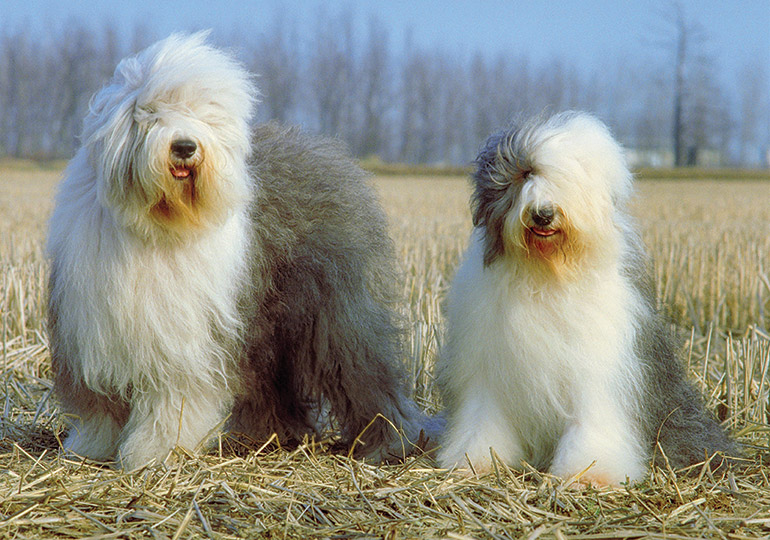
GROUP 5 - WORKING DOGS
The Old English Sheepdog is also known as the “Dulux Dog”, having been seen in many advertisements, movies, television and cartoons in recent times, and is instantly recognisable for it’s rolling, bear-like gait and profuse grey and white coat.
An Old English Sheepdog appears in a portrait of the Scottish Duke of Buccleuch, by Thomas Gainsborough, as early as 1771 (see image to left). This is generally regarded as the earliest visual of this breed. It is believed that the breed resulted from the crossing between the South Russian Ovchartka and the Briard or the Scottish Bearded Collie. It was bred as a working dog, originally used for driving sheep and cattle in the UK throughout the 18th and 19th century. In the mid 19th century the breed was first brought to Australia, and as well as being a working dog it also served as a companion dog to the shepherds.
The Old English Sheepdog was also known as the “Bobtail,” due to the fact it’s tail was traditionally docked. This was apparently done because taxes in the 18th century in the UK were levied on pet dogs but not on working dogs; hence docking the tail was one way to identify the working dog. The custom to dock tails was carried out until the ban on docking tails was introduced. This ban was imposed in New South Wales from 1st June, 2004 and on other dates in different places around the world.
Their use as working dogs on Australian farms ceased due to fencing of most properties and also the recognition of more suitable breeds for the job.
The Old English Sheepdog is described as being a “strong compact-looking dog of great symmetry,” “absolutely free of legginess” and “profusely coated all over”. In the show ring a dog in full coat should have a profile that is almost perfectly square, with the distance from the ground to the crown of the head being the same as that from the nose to the hindquarters. Unusually, the dog stands lower at the shoulders than at the loin. Their walk has a characteristic ambling or pacing movement.
They are described as “a biddable dog of even disposition, bold, faithful and trustworthy, with no suggestion of nervousness or unprovoked aggression”. They are required to have “a most intelligent expression”. It is said they are lovable and loyal and possess a definite sense of humour – a shaggy clown. They have great stamina and can demonstrate explosive energy, interspersed with long periods of snoozing. In spite of their size they are not an exercise intensive breed. They can happily live in an apartment, if walked daily and given a free run from time to time.
Most of the health issues of the Old English Sheepdog are similar to any large breed: hip dysplasia, for instance, is a risk that should always be monitored. All breeding dogs should have their hips checked and scored by a vet before breeding. Like any breed, and especially those which spend large portions of the day resting, the Old English Sheepdog should not be allowed to become overweight. Ideal weight for an adult dog should be 38-39kg and a bitch slightly less.
They are very well suited to a family with children and will naturally want to play. This can be unnerving for children who are not accustomed to the exuberant, large and friendly dog. However, the Old English Sheepdog will quickly calm down (and more often than not go to sleep on your lap) after meeting and greeting any visitors. Conversely, he is an excellent and protective watchdog, and will respond rapidly and loudly, with his distinctive pot casse (deep) bark, to an unfamiliar noise.
If the Old English Sheepdog is kept in full coat it is crucial that the coat not be allowed to become matted. A matted coat will trap dirt and in the summer months especially, it will become uncomfortably hot for the dog. A dog in full coat will require three to four hours of grooming each week, plus another couple of hours to wash and dry when necessary.
Information from The Old English Sheepdog Club (NSW)
Now you know a little about the Old English Sheepdog you may have think that this is the dog for you. Before you make a decision, please make contact with the breed club or your State controlling body for purebred dogs. They will be able to give you information about available puppies and also suggest dog shows where you can see the breed and speak to breeders. In this way you will gain a better perspective of the Old English Sheepdog and its needs and whether this breed would suit your lifestyle.